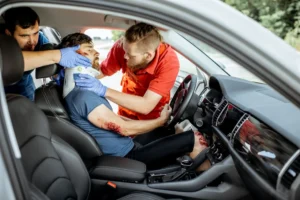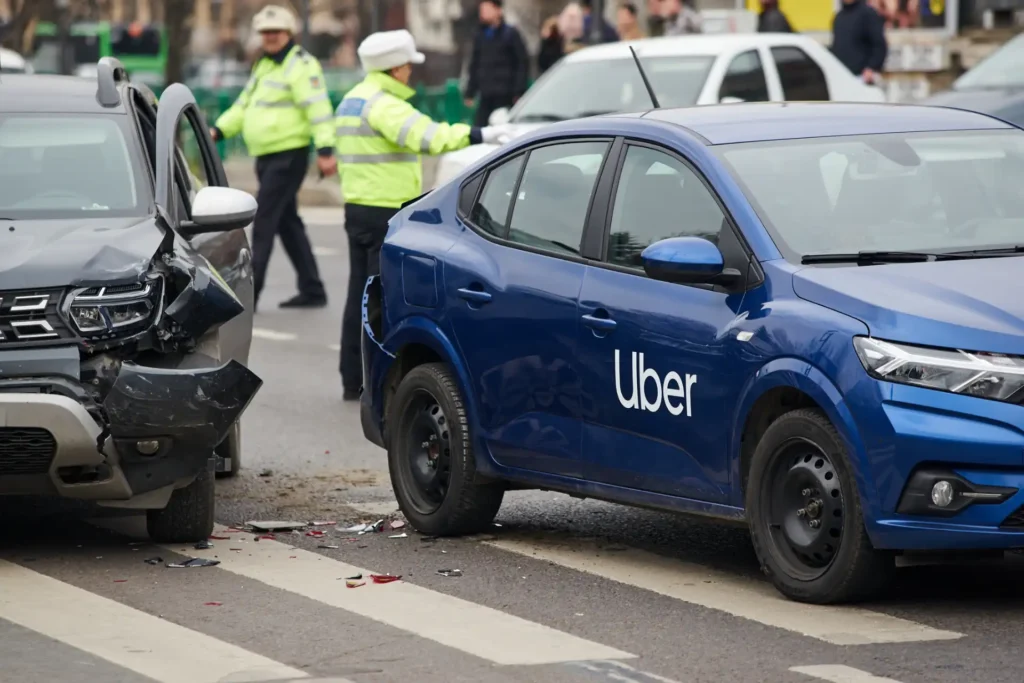Ridesharing services like Uber and Lyft have transformed how you get around, especially in busy cities. With millions of daily trips, these platforms offer convenience, but the roads remain unpredictable.
Accidents involving rideshare vehicles are now a common risk—dense traffic, distracted drivers, and unfamiliar routes all play a part. If you find yourself involved in a rideshare accident, knowing what to do immediately is essential for your safety and legal protection.
Why immediate action matters:
- Preserves evidence needed for insurance and legal claims
- Ensures your physical well-being and that of others
- Reduces the chance of costly mistakes down the road
Understanding the right steps—from the moment of impact—empowers you to handle an Uber accident or any rideshare crash confidently. This guide covers exactly what to do after a rideshare accident so you can protect your rights every step of the way.
1. Ensure Safety First
 When a rideshare accident happens, personal safety is the immediate priority. Taking the right steps quickly helps prevent further harm and sets the stage for a responsible emergency response in a rideshare context.
When a rideshare accident happens, personal safety is the immediate priority. Taking the right steps quickly helps prevent further harm and sets the stage for a responsible emergency response in a rideshare context.
- Assess injuries: Check yourself first for any pain or visible injuries before assisting others. If you’re able, look for signs of injury in passengers, the driver, and anyone else involved. Avoid moving anyone unless there is an urgent risk, such as fire or oncoming traffic.
- Call emergency services: Dial 911 if there are any injuries or if someone appears disoriented, bleeding, or unable to move. When speaking to emergency responders, mention it’s a rideshare accident so they can coordinate appropriate resources.
- Relocate safely if possible: If vehicles are blocking traffic and it’s safe to do so, help move everyone to a secure spot away from the flow of cars. Staying clear of active lanes reduces the risk of secondary accidents and helps keep everyone safer until help arrives.
Rideshare accident safety relies on rapid assessment and action. Keeping calm while following these steps supports your well-being and protects those around you during unpredictable situations.
2. Report the Accident
Prompt, accurate reporting sets the foundation for any insurance or legal claim. Notifying local law enforcement is a critical step—police will document the scene and create an official report, which serves as a key piece of evidence.
Why alert authorities?
Law enforcement documents facts impartially, capturing details you might overlook in a stressful moment. When you report a rideshare accident to authorities, you protect your rights and ensure there’s an objective record.
How to notify rideshare companies:
Use the app’s built-in safety or help features to report the incident. Both Uber and Lyft allow riders and drivers to submit accident details directly through their customer support channels. Provide basic facts, including time, location, and parties involved.
Police reports in claims:
Insurance companies rely heavily on police documentation when assessing fault and processing claims. A law enforcement report for a rideshare accident carries authority in disputes over liability or compensation.
Thorough reporting prevents confusion later, especially when multiple parties or insurers become involved.
3. Document Everything
Accurate documentation plays a critical role in what to do immediately after a rideshare accident. The more details you collect at the scene, the stronger your case will be when dealing with insurance companies or legal claims.
- Take clear, timestamped photos:
- Capture all vehicle damage from multiple angles, photograph road conditions, skid marks, debris, and nearby traffic signals or signs, and include pictures of any visible injuries on yourself or others.
- Write detailed notes:
- Record the exact time and location of the accident, list weather conditions and lighting at the scene, and describe how the incident unfolded—include the sequence of events leading up to and after impact.
- Collect witness information:
- Ask bystanders for their names and contact details, and note their observations for potential future statements or testimony.
Keeping thorough records helps document rideshare accident scenes accurately. Accident scene photos and witness accounts often serve as crucial evidence for insurance adjusters, police investigators, and attorneys.
4. Gather Trip Information from Your Rideshare App
Preserving your rideshare trip details after an accident is essential for insurance and legal clarity. Your app holds a record of the ride, which can help establish facts and timelines.
- Take screenshots of the ride summary page, showing the driver’s name, vehicle information, pickup and drop-off points, trip route, and timestamp of the crash.
- Capture your passenger status at the time of the incident. This detail often determines which insurance policy applies.
- Save any in-app communications with the driver or support team—these messages can clarify what was said and when.
- For Uber trip info collection, go to your ride history, select the specific trip, and document all visible details. Lyft and other platforms offer similar options in their ride history sections.
This digital evidence forms a crucial layer in your claim file. Insurance adjusters and legal professionals often rely on these records to verify your version of events. You protect yourself by having a clear, time-stamped trail that’s hard to dispute.
5. Seek Medical Attention ASAP
Injuries from a rideshare accident are not always obvious at the scene. Even if you feel fine, issues such as whiplash, soft tissue damage, or internal injuries can develop hours or days later. Ignoring these delayed injury symptoms may lead to worsening health problems and complicate future claims.
Steps to protect your health and legal case:
- Get a medical checkup post-rideshare accident as soon as possible—even for minor aches or discomfort.
- Inform your healthcare provider that you were involved in a motor vehicle accident so they can document relevant symptoms and injuries thoroughly.
- Request a copy of all medical records and keep receipts for any expenses related to your treatment.
Prompt evaluation by a medical professional provides critical documentation for insurance purposes and protects your long-term well-being. This record links injuries directly to the accident, making it harder for insurers to dispute your claim.
6. Understand Insurance Coverage in Rideshare Accidents
Rideshare insurance coverage explains the protections available after a rideshare accident change depending on the driver’s status in the app and your position as a passenger.
1. Driver App Off
When the driver is offline, only their personal auto insurance applies. These policies often provide minimal coverage—typically between $15,000 and $30,000 for bodily injury per person.
2. App On, No Passenger
If the driver is waiting for a ride request, Uber and Lyft offer limited liability coverage, but it’s lower than when carrying a passenger.
3. En Route or With Passenger
Uber insurance policy details are clearer when a ride is active. Both companies provide up to $1 million in liability coverage for injuries and property damage.
Multiple insurers may become involved—personal auto insurers, the rideshare company’s insurer, and sometimes third-party policies. Sorting out who pays what can be complex, especially if injuries are serious or there are disputes over fault. Knowing what to do immediately after a rideshare accident includes understanding these layers of coverage so you’re not caught off guard during the claims process.
7. Consult an Experienced Rideshare Accident Lawyer
 Insurance companies often look for ways to minimize payouts or deny claims outright, especially in complex rideshare accident scenarios. You may face confusing policy language and shifting liability between multiple insurers. Retaining a rideshare accident attorney brings several clear benefits:
Insurance companies often look for ways to minimize payouts or deny claims outright, especially in complex rideshare accident scenarios. You may face confusing policy language and shifting liability between multiple insurers. Retaining a rideshare accident attorney brings several clear benefits:
- Expert handling of insurance negotiations: A specialized attorney understands the tactics insurers use and knows how to counter lowball offers, ensuring your claim is taken seriously.
- Maximizing compensation: An Uber accident lawyer can identify all available sources of recovery—whether for medical bills, lost wages, vehicle repairs, or pain and suffering.
- Protection in severe cases: Legal representation is crucial if you are dealing with catastrophic injuries or wrongful death. Your attorney will gather evidence, handle communications, and protect your rights throughout the process.
A skilled rideshare accident lawyer navigates policy complexities so you can focus on recovery instead of paperwork or legal loopholes.
Conclusion
Staying calm and focused after a rideshare accident ensures you gather the details that matter. Quick action—documenting evidence, seeking medical care, and collecting key information—protects your rights from the start. Legal counsel plays a crucial role when dealing with multiple insurers or complex claims. If you’re searching for a summary of rideshare accident steps taken post-incident or wondering what to do immediately after a rideshare accident, prioritizing both documentation and professional guidance is essential to secure your safety and future compensation.

